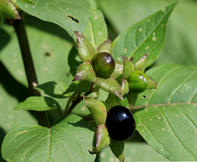Black nightshade (Solanum retroflexum) is an annual herb-like plant that originated in South Africa. It is also known as sunberry, nastergal, Umsobo, muxe, umsobo wesinja, umosobosobo and lintsontso.

It is considered a ‘weed’ by some people, however, it is often found in soil rich in nitrogen, and is considered an important green leafy vegetable that is cultivated in homesteads around South Africa.
There are many other ‘Solanums’ in the family, most notably Solanum nigrum (common nightshade or poisonberry), Solanum tuberosum (potato) and Solanum lycopersicum (tomato). ‘Nightshade’ contains many species and its taxonomy is complicated. In South Africa S. americanum, S. nigrum and S. retroflexum are the most commonly used species.
Black nightshade grows up to 75 cm high and forms a round bush with purplish stems and grey-green leaves. Flowers are simple with white petals and a yellow centre that produce green berries, which change to dull purple-black when ripe.
The berries, fresh leaves and tender shoots can be eaten. Do not confuse the Solanum retroflexum’s berries with those of the deadly nightshade (Atropa belladonna). The deadly nightshade’s berries are shiny and its flowers are purple, not white.
How to Grow Black Nightshade
Black nightshade is easy to grow and is best sown from seeds and transplanted as seedlings. Cultivation of black nightshade by seedlings can yield a harvest of 1.2 kg/m2. It can tolerate most soils and harsh conditions but prefers moist soil. It cannot grow in the shade.
Research has shown that black nightshade needs nitrogen (N) and phosphorus (P). This can be applied in the form of a chemical fertiliser, such as 2:3:2 or 3:2:1. at the rate of 40 g/m. A normal size teacup takes about 200 g fertiliser so this would cover 5 m. Place fertiliser in-furrow and mix with soil before planting.
The Department of Agriculture, Forestry and Fisheries recommends the following: when using poultry or pig manure apply a 10 lt bucket in a band of about for 20 cm wide over a length of 15 m. The same quantity of manure is used even for kraal manure to cover a 5 m length area. After sowing cover the beds with a mulch like dried grass to retain moisture.
Although black nightshade is drought resistant, it needs water as this will improve yield - at least 4 litre per 1 m². Pests of black nightshade, ants, black aphids, caterpillars, grasshoppers and beetles, are controlled by crop rotation or wood ash dusted on leaves. Choose companion plants like onion and garlic, which are natural flea-beetle repellents.
Black nightshade is sensitive to blight (early blight, leaf blight), viruses, such as leaf curl, yellow vein, as well as grey mould and powdery mildew. Optimum growing condition and good soil conditions can help in disease reduction.
A Practical Example of Planting Nightshade
About 2 ha of black nightshade was planted commercially on a farm between Memel and Newcastle. Seedlings were planted in late October in two rows ber bed. Beds were 5 m apart to allow for mechanical weeding. Each row had dripper irrigation and was covered with plastic sheeting with holes for the seedlings.
To spread the berry harvest, seedlings were planted at three-week intervals. The yield was around 1.5 t/ha, but closer spacing could yield up to 2,5 tons of berries per hectare. Local women hand-picked the berries and were compensated for every kilogram they picked. The jams (in Afrikaans ‘nastergal konfyt’) were marketed as Umsobo, the Zulu name for black nightshade.
How to Eat Black Nightshade
The best way to harvest nightshade leaves is to cut the entire shoot, as this stimulates re-growth. Regular harvesting of the young shoots and de-budding encourages lateral shoots and extends the harvesting period. Leaves can be harvested until the berries start to develop. After that, leaves become leathery.
When used as a leafy vegetable, the leaves and tender shoots of nightshade are harvested and cooked but leaves can also be eaten raw.
The cooked leaves are often served as a relish. Its toxicity is not clear but the green (unripe) berries contain solanine, which causes a degree of poisoning. Berries are hand-picked when purple-black, usually from January to April.
The berries need to be picked without the calyx (outer hard cup-like ‘petals’ of the berry) or it must be removed before you cook them. (Hold the berries and pull the calyx off sideways.) The berries can be eaten raw or cooked, but the flavour improves with cooking.
The fruit was found to be much nicer although smaller than the rather similar Solanum nigrum var. guineense, it has a sweeter flavour. The berries are often processed to make a jam, which is a rare delicacy and sometimes found at farm stalls.
The berries can also be used as a salsa or salad-dressing: add crushed nightshade berries to sautéed garlic and onion, caraway and sesame seeds, olive oil and balsamic vinegar. Use with sautéed nightshade leaves and top with feta. Alternatively, spread over fish.
Medicinal Uses of Black Nightshade
The leaves are can be used as a poultice to treat cancerous sores, wounds and leucoderma (a condition where the pigment is lost from areas of the skin, causing white patches). Research has confirmed that Solanum nigrum has anti-herpes properties.
It is used to induce sweating, is a painkiller and a sedative, but it is unclear if this also applies to Solanum retroflexum. Note: Harvesting wild edible plants can be dangerous and should only be done by an experienced knowledgeable forager. Inexperienced people may become sick or die by eating the wrong plant.